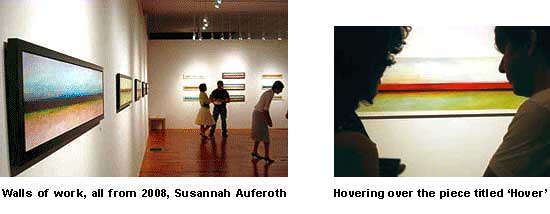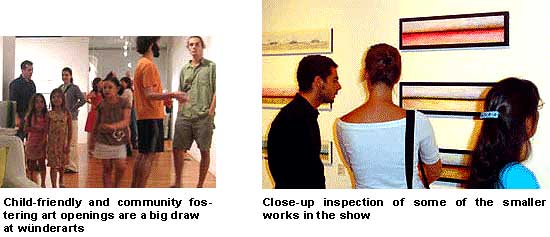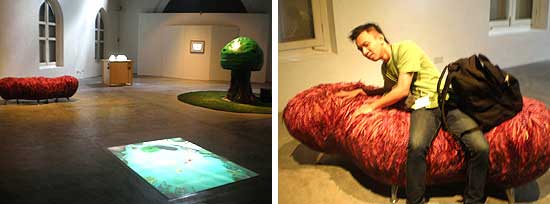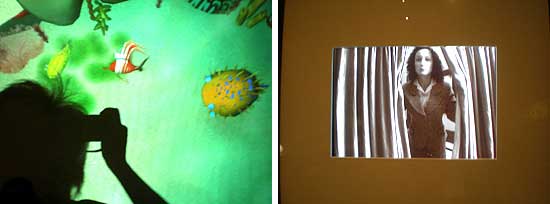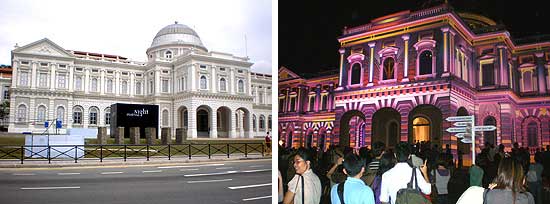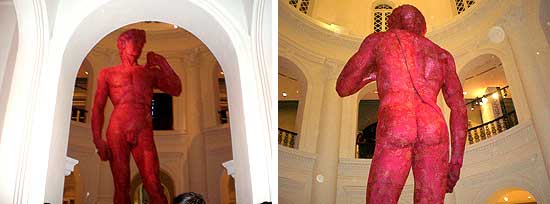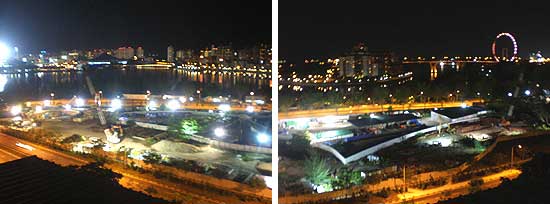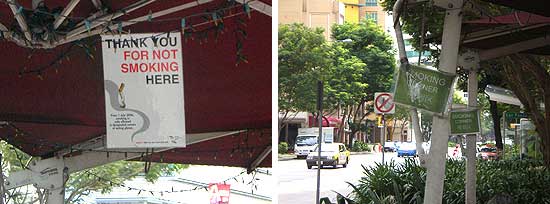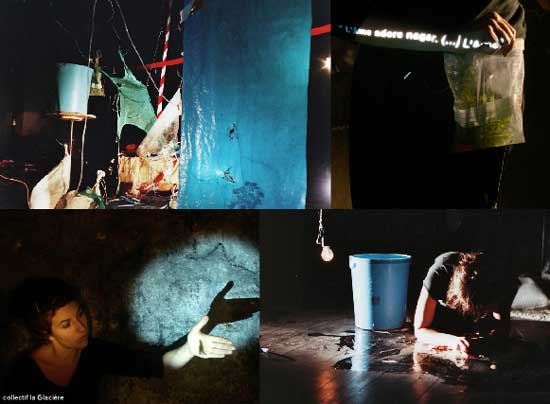Friday, August 29th, 2008
Susannah Auferoth at wünderartsAmherst Massachusetts
GIFT
by correspondent, Richard Lloyd
Susannah Auferoth’s exhibition of new paintings opened recently at the wünderarts Gallery in Amherst Massachusetts. wünderarts is a new gallery in Western Mass. They have planted their flag in the ground and are staking out a territory all their own in the Pioneer Valley gallery scene. These new paintings are vigorous and if you live in the area I recommend you make your way to the gallery to see them in real time and place.
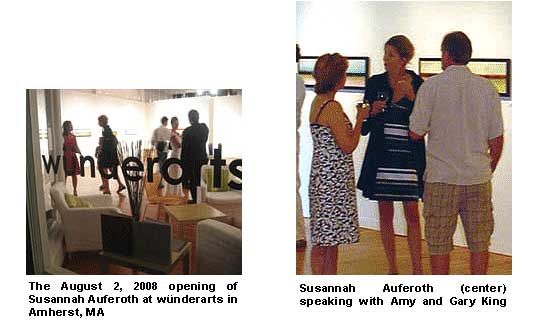
In her published statement about the work, Auferoth describes a process of layering thin washes of color one on top of the other. The results are beautiful. Auferoth is a colorist. She mentions Richard Diebenkorn, and Philip Taaffe as touchstones. Here she continues her own exploration of subtle color manipulation on an intimate and delicate plane. The paintings are deceptively simple in appearance. Three luminous bands of color run horizontally and form a foreground, background and a horizon line that bisects the painting in the center. The horizon line is a band unto itself and typically darker and more ominous.
When looking at these works my initial association is: landscape.But whose landscape? The paintings are windows into the world we share today. What do you see? Is this the Thai beach sunrise for a twenty-something post-grad tourist? Or is it sunset on the killing fields of Darfur? Is it Hadley or Osetia? To my eye the paintings flicker between all these places.
Their size is important. They feel like scrolls that have been placed sideways on the wall. Long and horizontal yet small enough to be seen all at once. The events depicted here are ongoing, they haven’t ended and the beginnings are far, far away. Think of what happens to what you see if you are moving fast enough – a smudge of colors all being pushed together in a fat line across your cones and rods; or when you stare at a blade of grass long enough and something similar happens. These paintings are peepshow slots into that world.
In some of the paintings you can see serialized images buried in the ground of the work behind the bands of horizontal color. This sets up an optical back-and-forth that animates the surface. What are these images? – and what are they doing there? Auferoth is dropping hints. It feels as though we are listening to a hushed conversation in the next-door motel room. The walls are thin but the actual words are still indistinct. You will need your intuitive channels opened up and humming.
These works speak to the traveler in us all. They are simultaneously hopeful and foreboding. I kept being thrown back and forth on an emotional Tilt-a-Whirl; one moment staring at the world – post-apocalypse, empty, lifeless and still, and at the next blink standing at the edge of a new world – full of nascent life, on the verge of becoming.
current exhibition through September 7
Susannah Auferoth, who has both a mechanical engineering and fine arts degree from UMASS Amherst, returned with her family to the Valley from New York City in 2001, and lives and works in a historic farmhouse in Hatfield that she and her husband have updated to suit their family’s lifestyle. The artist works in her home studio where she creates paintings on paper and wood panel that explore color, form, and meaning. While their horizontal orientation and bands of color evoke more traditional land or waterscapes, the inclusion of repeated images or figures in Auferoth’s paintings adds a layer of complexity and mystery while increasing the inherent abstraction of the works.
Richard Lloyd lives and works in Northampton Massachusetts.wünderarts (wunderarts.com) is located at 383 Main Street in Amherst, Massachusetts, is currently exhibiting GIFT, featuring paintings by Susannah Auferoth and Hillary Milens. The show, also marking the gallery’s one-year anniversary, opens with a reception on Saturday, August 2 from 6-9 p.m. and runs through September 7. Hillary Milens, a graduate of UMASS’ Fine Arts program, and the Executive Director of the Amherst Community Art Center was born and raised in Burlington, Vermont. After concentrating mainly in sculpture while at UMass, she began experimenting with drawing and painting. An exploration of surface, texture, and color, her paintings are made by building up and breaking down the surface of wood by applying layers of paint, scraping in
to it and marking the surface with various tools and techniques. An interest in repetition, organic form and the meditative process are present in the paintings. In addition, works by Italian artist Alberto Mancini based on his concurrent exhibition of paintings – I’ll tell you how the Sun rose – inspired by the poetry of Emily Dickinson, will be on view in the rear of wünderarts for the duration of GIFT. Mancini’s show, on view from August 2 – 10 at the Eli Marsh Gallery at Amherst College, is sponsored by the Emily Dickinson Museum, and includes 29 paintings inspired by Dickinson’s poetry. The exhibition is part of the 20th anniversary of the Emily Dickinson International Society (EDIS), which holds its annual meeting in Amherst on the weekend of August 1. For more information on Mancini and the exhibition, please visit www.emilydickinsonmuseum.org.
#permalink posted by Richard Lloyd: 8/29/08 05:56:00 PMMonday, August 25th, 2008
CAMOUFLASH – DRESDEN
Curators:
Mariusz Sołtysik, Aurelia Mandziuk and Anja Tabitha Rudolph
Organizator: UNOACTU
co-organizar: PATIO Art Center, Academy of Humanites and Economics in Lodz.
http://www.unoactu.org/en_camouflash.html
http://patio.art.pl/wystawa.php?id=40
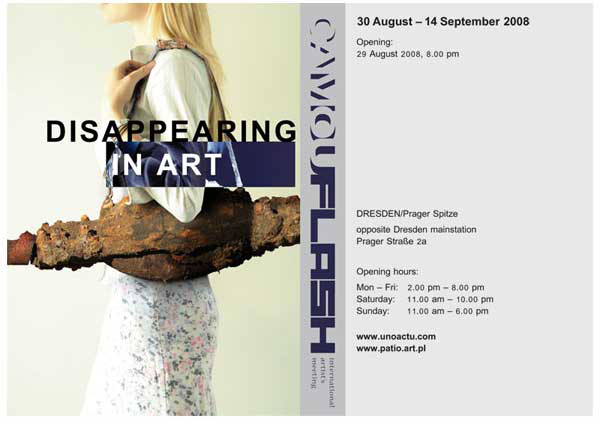
SHILPA GUPTA (India), KATHERINE BEHAR (USA), ALLAN HUGHES (Northern Ireland), REINIGUNGSGESELLSCHAFT (Dresden), JANUSZ BALDYGA (Poland), ERIC VAN HOVE (Belgium), HARRO SCHMIDT (Hanover), MARIUSZ OLSZEWSKI (Poland), ULU BRAUN (Berlin), MARKUS HUEMER (Berlin), AKI TARR (Dresden), DANIEL BIESOLD (Berlin), SUZY SUREK (USA), TAKAKO KIMURA (Japan), YOSHIAKI KAIHATSU (Japan), ERIKA KNERR (USA), DANIEL RODE (Dresden), ANDREAS SACHSENMAIER (Berlin), OLGA BERGMANN (Iceland), TATSUYA HIGUCHI (Japan), ARIANNE OLTHAAR (Netherlands), DIETER LUTSCH (Berlin), CHRISTINE MACKEY (Ireland), KRISTAPS GULBIS (Latvia), ANDRÉ MAROSE (Berlin), ANNA MACLEOD (Ireland), BERND IMMINGER (Berlin), JESSICA HIGGINS (USA), MARTIN BRAZINA (Czech Republic), EWA SZCZYREK-POTOCKA (Poland), GABRIELE HORNDASCH (Düsseldorf), MARIUSZ SOLTYSIK (Poland), MIYUKI YOKOMIZO (Japan), TOMASZ WENDLAND (Poland), BOSSE SUDENBURG (Berlin), TOMASZ MATUSZAK (Poland), ADAM KLIMCZAK (Poland), PIA MÜLLER (Düsseldorf), AISLING O´BEIRN (Northern Ireland), TOBIAS HANTMANN (Cologne), GRIT RUHLAND (Wuppertal), CHARLIE CITRON (USA), SARA PFROMMER (Dresden), NÁNDOR ANGSTENBERGER (Berlin)
CAMOUFLASH Cinema:
DISORIENTALISM (USA), DONG JOO LEE (South Korea), LUKASZ OGOREK (Poland),
KRZYSZTOF LUKOMSKI (Poland), SARAH BROWNE & GARETH KENNEDY (Ireland), AGNIESZKA CHOJNACKA (Poland), MARINA NAPRUSHKINA (Belarus), HENRIK BUSCH (Dresden), RICHARD THOMAS (Australia), WIKTOR POLAK (Poland), SUSANA PEDROSA (Portugal), CARLOS ALBERTO CARRILHO (Portugal)
Concept/Realisation Entry:
NEULANT VAN EXEL (Berlin)
The group UNOACTU based in Dresden, Germany, in cooperation with the Patio Art Centre Lodz, Poland is presenting the exhibition CAMOUFLASH – DISAPPEARING IN ART to open this friday 29 August, 2008. CAMOUFLASH began as an international artist’s meeting that was led by polish artist and curator Marius Soltysik, in Lodz, that I covered in October 2007.
For Dresden Soltysik’s concepts were used and the original group from Lodz is all exhibiting here. UNOACTU has broadened the theme that Mariusz began, based on concepts of Baudrillard’s theories. They have compared the ideas of other philosophers working in this arena, as well as consciously picked a location right next to the shopping mall across from the central train station in Dresden, which instantly underscores the theme. This project has created an intensive exchange between German and Polish artists.
More than 50 works of contemporary art will be exhibited in the building “Prager Spitze,” by artists from Japan, the USA, Australia, India and several European countries.
Many of the artists are arriving now to set up their installations and prepare for the opening. Another artist from New York, Katherine Behar, will begin a performance starting at the former Zentrum Warenhaus down the Prager Straße to the Prager Spitze, an hour before the official opening at 8 pm. Other talks, performances and a concert will follow.
MEDIATIONS Biennale in Poznan (www.mediations.pl) will present a selection of the artworks – about half of the exhibition – in October 2008.
Camouflash
The Disappearing in Art
Camouflash generates significant meaning through the combination of the words “camouflage” and “flash” which describes a paradox or convergence of opposites. “Camouflage” means both camouflage and hidden nature, and, “flash,” means a spark – an outstanding moment or message that is visible only for a short moment. This is an allusion to the schizophrenia of modern human beings in the society of media communication and public performance. Their endeavour culminates in competing moments, those of hiding and those enabling them to stand out in the crowd for a short moment – to gain identity for an instant. This topic is presented to the public directly in one of those places – where this schizophrenia is celebrated in a pre-eminent manner – within a shopping centre across from the main station in Dresden.
The subtitle “Disappearing in Art” departs from Baudrillard’s conceptual background. The entrance of the worlds of simulation and a matrix, sounded merely apocalyptic in the philosophy of the 80’s. The disappearing in the arts gives evidence to a process that existed in the past. If it is possible to pause, then options could appear that are yet unknown and altogether different than the proclaimed tendencies leading to an abrupt ending. The double meaning of the subtitle leads us to contradicting possibilities of interpretation. There opens space for associations creating significance. The merging of the dimensions of reality and arts into each other and the entailed reduction of their operation fields and efficiency might be interpreted, as well as simply dealing with this topi
c in the arts. Whereby the second in particular, enables a sober reflection of the process itself.
MS & ATR
#permalink posted by Erika Knerr: 8/25/08 06:21:00 PMMonday, August 4th, 2008
ISEA 2008
Singapore
International Symposium on Electronic Arts
By Mina Cheon
ISEA 2008, International Symposium on Electronic Arts, in Singapore is pure elegance.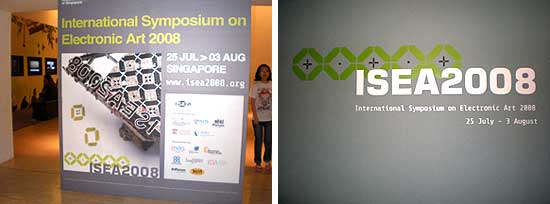
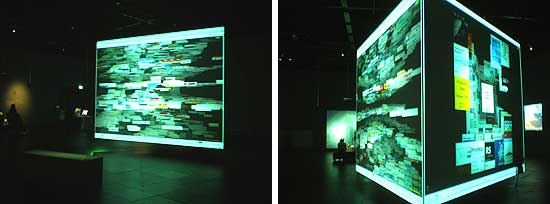 “Exodus” by Metahaven
“Exodus” by MetahavenThe monumental installation “Exodus” by Metahaven from Amsterdam and Brussels, hosted by Lab for Media Research, display the output of a programmed visual search engine. It is written that it is a “research engine” that uses “algorithms and visual strategies for searching the Internet, revealing the structural properties of web content and its inherent distribution of influence.” This project comments on the information hierarchy presented by search engine systems, which information is given priority and which is left behind, and questions how that is determined. http://www.metahaven.net 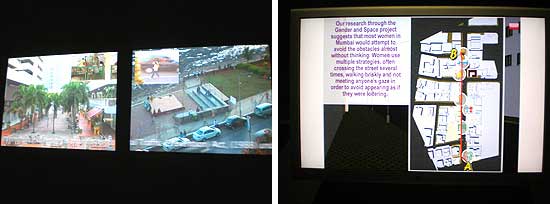 Loitering” by artists Shilpa Phadke, Shilpa Ranade and Sameera Khan
Loitering” by artists Shilpa Phadke, Shilpa Ranade and Sameera Khan
“Gendered Strategies for Loitering” by artists Shilpa Phadke, Shilpa Ranade, and Sameera Khan from India, and in collaboration with University Scholars Programme Cyberarts Studio, traces women loiterers in Mumbai, India. Although it is common for men to loiter and just hang around, the project looks at the stereotype produced when women do it. The differentiation of social connotation when women are loitering demarcates public spaces as gendered spaces. Hence, the piece examines the gendering of space through the conceptual occupancy of loiter, which seems to be an acceptable male’s space. It is written that the “research through Gender and Space project suggests that most women in Mumbai would attempt to avoid the obstacles almost without thinking. Women use multiple strategies, often crossing the street several times, walking briskly and not meeting anyone’s gaze in order to avoid appearing as if they are loitering.” http://www.genderandspace.org 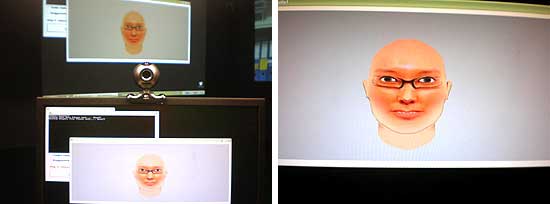 “Smile J, Wear It Like a Costume” by Momoyo Torimitsu
“Smile J, Wear It Like a Costume” by Momoyo Torimitsu“Smile J, Wear It Like a Costume” by Momoyo Torimitsu from Japan, and in collaboration with NUS Face Group, is an interface that captures the interactor’s face in order to re-make the snap shot of the face with a selectable palette of smiles. The many roles of smiles varies as much as the kind of smiles there are that people ‘put on’ daily. The piece reinforces the artificiality that comes out with the naturalness of smiling as well as how patterns can emerge through the staging of smiles, where facial gestures are the main interface for social communications. http://momoyotorimitsu.com 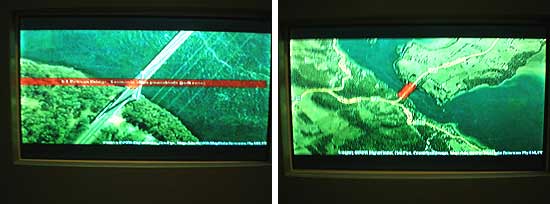 “The Global Bridge Symphony” by artist Jodi Rose
“The Global Bridge Symphony” by artist Jodi Rose
“The Global Bridge Symphony” by artist Jodi Rose from Australia, and collaborating with Ambient Intelligence lab and Communications Laboratory, display large columns dispersed throughout the gallery that show abstract to representational videos intersecting ideas, visuals, sounds, and text pertaining to the concept of the bridge. Hence, creating a symphony of bridges from all around the world in the exhibition space. One of the texts reads, “The most beautiful bridge in the world. So pure, so resolute, so regular that here, finally, steel architecture seems to laugh. – Le Corbusier.” And, another one states
that “The bridge is a location. It allows a space into which earth and heaven, divinities and mortals are admitted. The space allowed by the bridge contains many places variously near or far from the bridge. – Martin Heidegger.” http://www.singingbridges.net 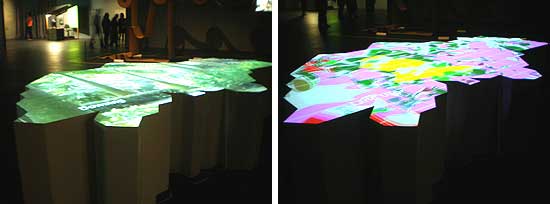 “Sourcing Water” by Shiho Fukuhata
“Sourcing Water” by Shiho Fukuhata“Sourcing Water” by Shiho Fukuhata from Japan, Georg Tremmel from Austria, with Yousuke Nagao, and hosted by Singapore-Delft Water Alliance (SDWA) deals with eco-resource concerns of water in Singapore. Since most of Singapore’s water is imported from Malaysia, the artists use dowsing rods with GPS and motion sensors to track water sources in Singapore and create visuals and maps of these potential water hotspots. http://bcl.biopresence.org/srch20 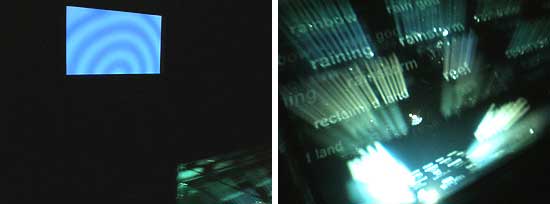 “The Water Book: An Encyclopedia of Water” by Clea T. Waite
“The Water Book: An Encyclopedia of Water” by Clea T. Waite“The Water Book: An Encyclopedia of Water” by Clea T. Waite from US and Germany, and in collaboration with Singapore-Deft Water Alliance (SDWA), creates another water piece that is interactive using text, water, touch sensor, and light. By interacting and touching the water, the viewers can experience sound and images related to the subject of water. The piece states how water” is the key component in the environmental transformation that the planet is now experiencing. It is the most powerful symbol of flow, purity and survival, and plays essential roles in our daily life as well as global geopolitics.” http://clea-t.de 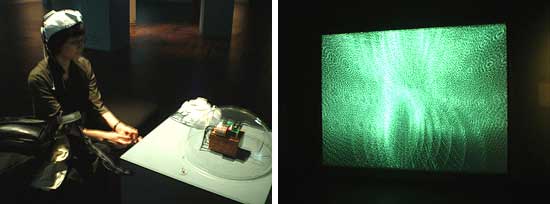 “Aurora Consurgens” by Horia Cosmin Smoila and Marie Christine Driesen
“Aurora Consurgens” by Horia Cosmin Smoila and Marie Christine Driesen“Aurora Consurgens” by Horia Cosmin Smoila from Romania and Marie Christine Driesen from France, and in collaboration with Mixed Reality Lab, creates visualization of brain waves. It is written, “The installation offers an alternative way to render the different states of consciousness through the exploration of cognitive conglomerates. The observer is invited to explore a paradoxical place of creation where the brain waves articulate the evocations of archetypal constructions…” http://ghostlab.org
Out of the partner exhibitions, Experimenta Play ++: Art for the 21st Century at the Sculpture Garden is a traveling exhibition, which has come to Singapore. It is an exhibition of Australian media art, curated by Caroline Farmer and Liz Hughes. It is unlike any of the other exhibitions with its playful and fantastical Alice in Wonderland appearance and interaction. http://www.experimenta.org A very warm reception by “Zizi the Affectionate Couch” (right) by artists Stephen Barrass, Linda Davy, Robert Davy & Kerry Richens. The piece is a furry couch that purrs and vibrates as one sits and cuddles it. The piece combines domesticated pets with comfort furniture as one assemblage.
“Immersion” (left) by Angela Barnett, Andrew Buchanan, Darren Ballingall, Chris MacKellar and Christian Rubino is a floor projection piece that creates 3D animated sea creatures by the interaction of one’s shadows. “The Shy Picture” (right) by Narinda Reeders and David MacLeod comprises of a small monitor on a large white wall where people in the video react based on the viewer’s proximity. The characters literally run away or shut the curtains in front of the interactor. The piece calls attention to the relationship between the viewer, camera, screen, and characters in the most delightful and charming way while intrinsically commenting on filmic issues of voyeurism and exposure.
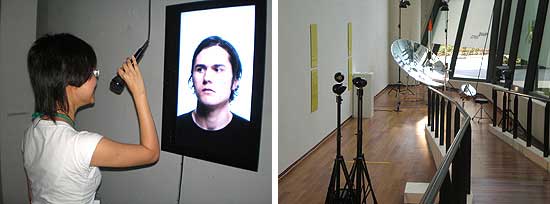
“Listening Heads” by Kentaro Yamada (left) allows interactors to speak into a microphone which then allows the faces on the screen to react differently according to the voices. This piece is eerie as the faces gestures real listening. This piece is in the exhibition Cloudland: Digital Art from Aotearoa New Zealand which is on view at The Substation. http://www.aotearoadigitalarts.org.nz The Lucid Fields exhibition which displays media artworks by Swiss Artists-in-Labs at the Lasalle college of Arts shows many works that contributed to the debates of scientific research. Out of them, “The Rocket for the Rest of Us” by Roman Keller is the “actual rocket…[that] results from collaboration with scientists in the lab on alternative future energies.” From the series of panels that are held at the Singapore Management University, Nanyang Technological University, as well as other spaces, “Borders Reckonings: Border Crossings” holds a lively discussion about the concept of borders: from borders that surround Austria, the North/South Korean border, Urban borders, to scattered borders which are everywhere; “Intelligent Architecture” panel presents alternative models of architecture thinking and Paul Thomas speaks about the transsubstantiation possibilities in architecture that can come with transgression devices such as in a non-perspectival method of mapping through GPS systems as a new mode of recording time and space.
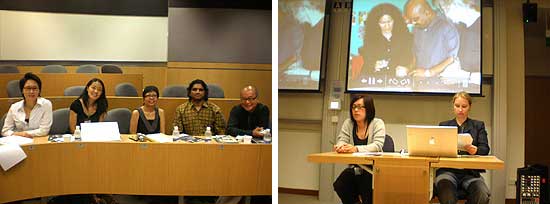
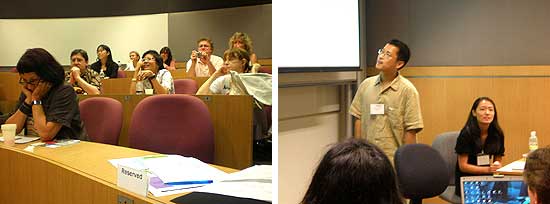
“Passing and Peril on the Information Super Highway”
(top left) chaired by Kóan Jeff Baysa deals with intense issues of racism, nationalism, and geo-politics in cyberculture. The panelists include: Mina Cheon, who presents Kenkanryu (The Hate Korean Wave) in Japanese Manga; Jiayi Young, who shows cyberculture in China and political blockage / censoring; Judy Sibayan, who publishes the most radical and subversive critical arts journal on-line Ctrl+P, and Roopesh Sitharan who examines bloggers gone politicians in Malaysia. “Locating Cyberfeminism” panel chaired by Irina Aristarkhova (top right) is a forum that voices the possibilities of the other in cyberfeminism and includes herself and Margaret Tan dialoguing about their experience with SubRosa in Singapore in 2003; Mara Tralla who looks at cyberfeminism from Estonia; Boryana Rossa, who sends a presentation from Bulgaria looking at the stereotype of women & machine that is found in popular cultures; and Mina Cheon who presents a paper on three Korean female artists while tracing the issues of displacement, performativity, and subjectivity in cyberfeminist discourse. Lastly, Artist & scientist team Jiayi Young and Shih-Wen Young, in the panel of arts & science intersection, shows their collaboration “Regular Irregularity (RI)” where through chaos theory, the minute change affects the outcome of the entire system. They show their project “Baby Nuna” where they utilize sounds from a nuclear powerplant in France to create a moving image representation as well as their recent piece on converting Chinese calligraphy and construction notes into scribbles of lines. This piece is being exhibited at the Beijing Chinese Biennale 2008, opening August 2nd and it is the Chinese Character Biennale at the KU Art Center, curated by Kóan Jeff Baysa.
ISEA 2008 is in Singapore from 25 July – 3 August.
Five Main Themes of the Symposium: Locating Media, Reality Jam, Wiki Wiki, Ludic Interfaces, and Border Transmission
Includes: Main Juried Exhibition, Partner Exhibitions, Keynotes, Invited Forums, Panels, Workshops, Media Presentations, Performances, and other events.
Website: http://www.isea2008singapore.org/
And Singapore Now:Event is “Night Festival,” National Museum of Singapore’s day appearance changes with color projection at night.
“Surrounding David” by Titarubi is at the lobby rotunda of the National Museum of Singapore. It is 8.5 meters tall.
Whose got the best view in Singapore? Korean journalist Yoolim Lee of Bloomberg, view seen from Golden Mile Tower.
Thank you for not smoking here. Smoking Area. These are examples of “scattered borders.” Singapore has the most prohibition notices one can ever see in a country. The country is unique for its commercial openness that comes with legal behavioral regulations.
#permalink posted by Mina Cheon: 8/04/08 01:05:00 PMMonday, June 30th, 2008
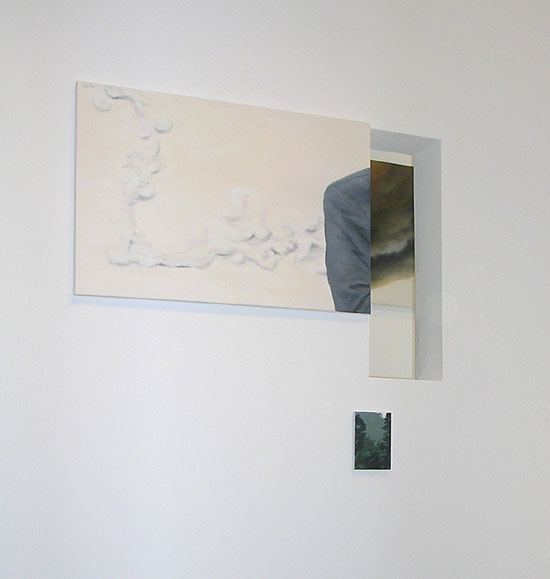 photo: Jean Pike, onsite view Site Santa Fe Biennial 2008
photo: Jean Pike, onsite view Site Santa Fe Biennial 2008
Overlaps and Relocations
New Architecture at the Site Santa Fe Biennial
Lucky No. 7
by NYC Artist Architect, Jean Pike
Site Santa Fe’s generic warehouse space was transformed for its 7th Biennial into a rich spatial experience by architects Todd Williams and Billie Tsien and unveiled during weekend opening events June 20-22. The architecture that was inserted into the space was an armature for movement and viewing and provides the thread that holds together a show of site-specific work by 25 artists from 16 countries.
Todd Williams and Billie Tsien, who had used ideas about “spatial curiosity” and “approaching” to generate a previous project with curator Lance Fung for the Snow Show in Torino, developed peripatetic ways of moving through the Site exhibition space that offer elevation changes (ramps, steps, balconies and raised walkways) and the possibility to perceive space, art and people from multiple angles, heights and perspectives. Spaces for moving become event spaces: locations for stopping, gathering, looking, listening, sitting, talking, art-making and other random actions.
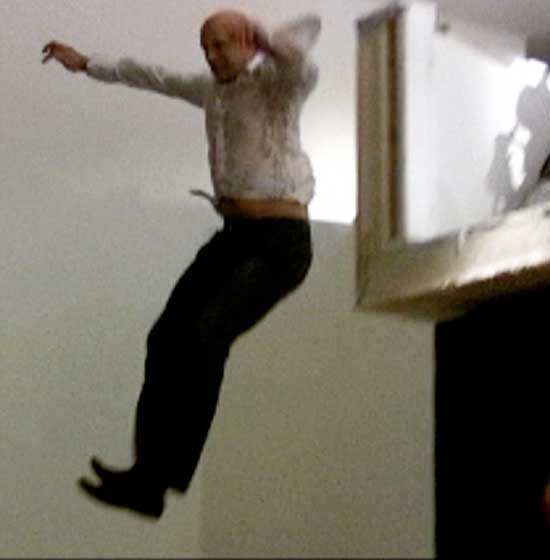 photo: Megan Fisher McHugh, courtesy of santafelucky7.com
photo: Megan Fisher McHugh, courtesy of santafelucky7.com
The exhibition space is largely defined by the presence of the surfaces upon which and within which one moves. Vertical walls, where they exist, are sometimes punctured, sometimes partial, allowing for moments of spatial transparency, parallax and specific perspective views. Because of the complex ways of moving and looking at the art one starts to perceive an overlap, an overlapping of spaces, of art, of one artist’s work upon another and of one location upon another, of digital onto analog and vice versa.
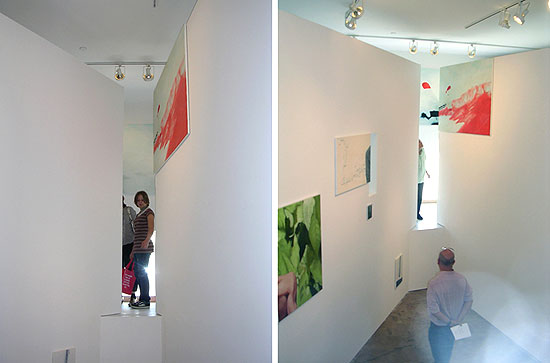
photo: Jean Pike, onsite view Site Santa Fe Biennial 2008
The idea of spatial overlap and extension mixes with the content and concepts of the art: paintings of internet images made in Korea and paintings of internet images made in Santa Fe (artist Soun Myung Hong), Mnemonic connections between disparate locations such as that which exist between Studio Azzurro’s interactive video projection, Fourth Ladder, and actual ramps with actual people climbing on them within the exhibition space, work like an alternating montage between digital and analog.
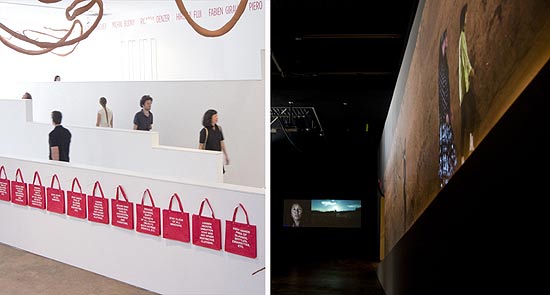
photos: BayAreaEventPhotography.com
Abduction, a work by Fabian Giraud and Raphaël Siboni also references alternate locations. Their piece, taken from a Santa Fe gallery, was transformed, installed at Site, and is intended to be relocated back to its original gallery after the Biennial closes, having been transformed yet again. Even the materials used for the architectural construction of the exhibition will be dismantled and reused elsewhere at the end of the show. Be it literal or conceptual, the offsite projects are now also overlapped onto the site, and a sort of simultanaeity begins to occur. Work created elsewhere and the sensibilities of artists from elsewhere, an interest in recyclable art-making materials and a spatial experience that, through movement and view, emphasizes montage, are all brought to bear on the site and reverberate back outward beyond its confines.
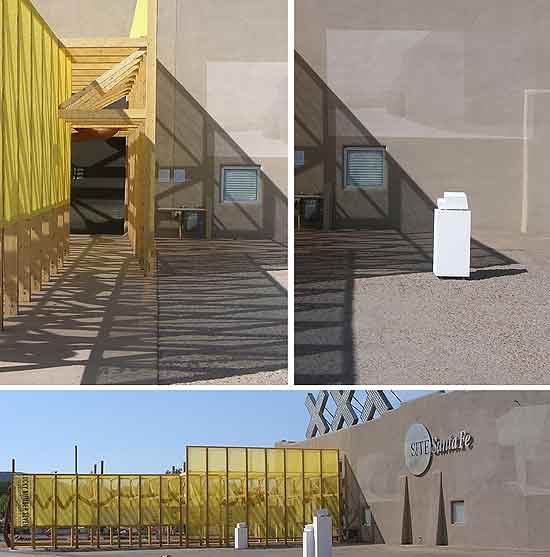
photo: Jean Pike, onsite view Site Santa Fe Biennial 2008
At the front, the new transparent entrance structure, built with manufactured materials, is a contemporary version of the traditional New Mexican ramada, a trellis-like structure made from wood branches that provides ventilation and shade in the harsh summer months. It’s moving shadows mix with the simulated and static (painted) projection images of Michal Budny and Zbigniew Rogalski’s Slideshow and vibrate with the complexity of here and now and then and somewhere else all at the same time. With the addition of the piece by Rose B. Simpson, Eliza Naranjo Morse and Nora Naranjo Morse snaking through, it makes a great introduction to the show, revealing all the passion and energy of the artists’, architects’ and curators’ work.
Can we, as Christine Boyer asks in reference to postmodern cities, “find the unity of community in this fragmented experience?” At Site we see our stories overlapping into new and exciting configurations that offer the promise of an even greater community, no matter how complex.
Jean Pike is an artist|architect living and working in New York City. She holds a Master of Architecture degree from the Yale School of Architecture. Her work has been shown at Viridian Artists Gallery in NYC, The California College of Arts and Crafts, The University of New Mexico School of Architecture and Planning Gallery, Tao Gallery in Hong Kong and Gallery 61 at The New York Institute of Technology. Her work is about translating between various forms of representation (abstract drawing, video) and three or four dimensional work (sculpture, architecture and installation). Coming from a background in dance, it is often about the physical sense of the body in space and time and how that relates to psychological and emotional states.
Lance M. Fung (fungcollaboratives.org) is the 2008 curator of Site Santa Fe Biennial titled “Lucky Number 7.” There are currently 25 artists from 16 countries participating including: Martí Anson, Fabio Cirifino, Paolo Rosa, Stefano Roveda, Leonardo Sangiorgi, Erick Beltrán, Luchezar Boyadjiev, Michal Budny, Ricarda Denzer, Hiroshi Fuji, Fabien Giraud, Piero Golia, Soun Myung Hong, Scott Lyall, Nick Mangan, Eliza Naranjo-Morse, Nora Naranjo-Morse, Ahmet Ögüt, Mandla Reuter, Nadine Robinson Born in 1968 in London, Zbigniew Rogalski, Wael Shawky, Raphaël Siboni, Rose B. Simpson and Shi Qing Born with a curatorial team including: Ferran Barenblit, Iara Boubnova, Gregory Burke, Colin Chinnery, Alexie Glass, Lukasz Gorczyca and Michal Kaczynski, Laura Steward Heon, Barbara Holub, Vasif Kortun, Chus Martinez, Martina Mazzotta, Tsukasa Mori and Yuu Takehisa, Joseph Sanchez, Patrizia Sandretto, Guillermo Santamarina, Hyunjin Shin, Alessandro Vincentelli, Marc-Olivier Wahler, William Wells, William Wells,
SITE Santa Fe was launched in 1995 to organize the only international biennial of contemporary art in the U.S. Conceived to bring the global contemporary art dialogue to the art-rich Southwest, and as a major event on par with such renowned exhibitions as the Whitney Biennial and the Venice Biennale, it has become an integral event for contemporary art aficionados, attracting tens of thousands of visitors from around the world. To date, SITE Santa Fe has successfully held six biennials, each of which has drawn worldwide attention and brought important contemporary art from all over the world to Santa Fe. Past biennial curators have either arrived as or have subsequently become superstars in the world of contemporary art. Following their SITE Santa Fe Biennial guest curatorships, Francesco Bonami (1997), Rosa Martínez (1999) and Robert Storr (2004) were chosen to organize the Venice Biennales in 2003, 2005 and 2007, respectively. Dave Hickey received the coveted MacArthur “Genius Award” after curating SITE’s Biennial in 2001. In 2006, Klaus Ottmann, a New York-based independent curator organized SITE Santa Fe’s Sixth International Biennial, Still Points of the Turning World that ran from July 9, 2006 to January 7, 2007.
Past artists have included: Marina Abramovic, Chema Alvargonzález, Francis Alÿs, Robert Ashley, Rebecca Belmore, Barbara Bloom, Imre Bukta, Carlos Capelán, Thomas Joshua Cooper, Braco Dimitrijevic, Felix Gonzáles-Torres, Ann Hamilton, Gary Hill, Jenny Holzer, Rebecca Horn, Anish Kapoor, Catherine Lord, Chie Matsui, Jakob Battner, Gerald McMaster, Bruce Nauman, Marta María Pérez Bravo, Alison Rossiter, Meridel Rubenstein, Andres Serrano, Lorna Simpson, Valeska Soares, Pierrick Sorin, Trinh T. Minh-ha, Tseng Kwong Chi, Millie Wilson, Massimo Bartolini, Vanessa Beecroft, Maurizio Cattelan, Olafur Eliasson, Giuseppe Gabellone, Kevin Hanley, Noritoshi Hirakawa, Gary Hume, Lukás Jasansky & Martin Polák, KCHO, William Kentridge, Suchan Kinoshita, Udomsak Krisanamis, Sharon Lockhart, Esko Männikkö, Tracey Moffatt, Chris Moore, Elizabeth Peyton, Huang Yong Ping, Tobias Rehberger, Miguel Rio Branco, Rudolf Stingel, SubREAL, Sam Taylor-Wood, Pascale Marthine Tayou, Jaan Toomik, Eulalia Valldosera, Helena Almeida, Ghada Amer, Janine Antoni, Monica Bonvicini, Louise Bourgeois, Tania Bruguera, Cai Guo-Qiang, Lygia Clark, Diller + Scofidio, Dr. Galentin Gatev, Greenpeace, Yolanda Gutiérrez, Mona Hatoum, Carl Michael von Hausswolff, Carsten Höller, Simone Aaberg Kærn, Zwelethu Mthethwa, Nikos Navridis, Shirin Neshat, Rivane Neuenschwander, Gabriel Orozco, Pipilotti Rist, Francisco Ruiz de Infante, Bülent Sangar, Arsen Savadov & Georgy Senchenko, Charlene Teters, Sergio Vega, Miwa Yanagi, Kenneth Anger, Jo Baer, Jeff Burton, James Lee Byars, Pia Fries, Gajin Fujita, Graft Design, Frederick Hammersley, Marine Hugonnier, Jim Isermann, Ellsworth Kelly, Josiah McElheny, Darryl Montana, Sarah Morris, Takashi Murakami, Nic Nicosia, Kermit Oliver, Jorge Pardo, Ken Price, Stephen Prina, Bridget Riley, Ed Ruscha, Alexis Smith, Rafael Soto, Jennifer Steinkamp and Jimmy Johnson, Jessica Stockholder, Jane and Louise Wilson, Ricci Albenda, Louise Bourgeois, Charles Burns, Francesco Clemente, Bruce Conner, R. Crumb, John Currin, Carroll Dunham, James Esber, Inka Essenhigh, Tom Friedman, Ellen Gallagher, Robert Gober, Douglas Gordon, Mark Greenwold, Lyle Ashton Harris, Jörg Immendorff, Jasper Johns, Kim Jones, Mike Kelley, Maria Lassnig, Sherrie Levine, Christian Marclay, Paul McCarthy, Jennifer and Kevin McCoy, Elizabeth Murray, Bruce Nauman, Hermann Nitsch, Jim Nutt, Tony Oursler, Gary Panter, Lamar Peterson, Raymond Pettibon, Lari Pittman, Sigmar Polke, Neo Rauch, Alexander Ross, Susan Rothenberg, Peter Saul, Jenny Saville, Thomas Schütte, Jim Shaw, Cindy Sherman, Laurie Simmons, Fred Tomaselli, Adriana Varejão, Davor Vrankic, Kara Walker, Jeff Wall, John Waters, John Wesley, Franz West, Lisa Yuskavage, Miroslaw Balka, Jennifer Bartlett, Patty Chang, Stephen Dean, Peter Doig, Robert Grosvenor, Cristina Iglesias, Wolfgang Laib, Jonathan Meese, Wangechi Mutu, Carsten Nicolai, Catherine Opie, Thorns Ltd.
#permalink posted by Jean Pike: 6/30/08 07:04:00 PMFriday, June 20th, 2008
Harvard Nashawannuck RemixNashawannuck Gallery Easthampton Massachusetts Meets
Harvard University’s Peabody Museum of Archaeology & Ethnology
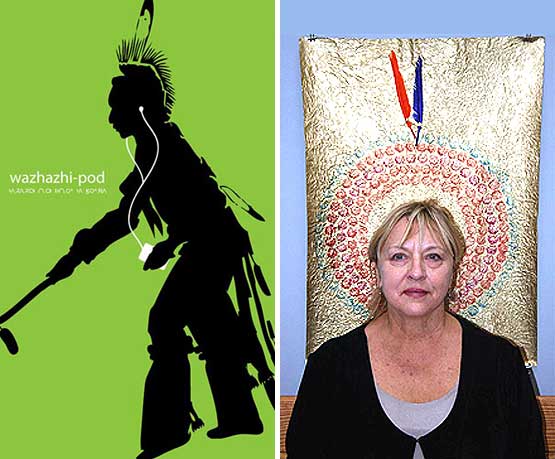
left: Ryan Red Corn, Wazhazhi-Pod, REMIX,
Peabody Museum of Archaeology & Ethnology, Harvard University
right: Dan Loudfoot, Everyone Wants To Be An Indian,
Nashawannuck Gallery, Easthampton, Mass
by artist Nayana Glazier
From April 1st through the 30th at Nashawannuck Gallery located at 40 Cottage St. in Easthampton MA (nashawannuckgallery.com) hosted “Untold Stories & Native Voices.” Participating artists were Dan Loudfoot, based in Brooklyn, NY with the tribal affiliation of Pequot. Courtney Leonard, based in Providence RI with the tribal affiliation of Shinnecock. Peter McLean based in Connecticut with no tribal affiliation and myself, Nayana Glazier, based in Massachusetts and affiliated with the Ojibwe and Potwatami of the Wikwemikong first nation.
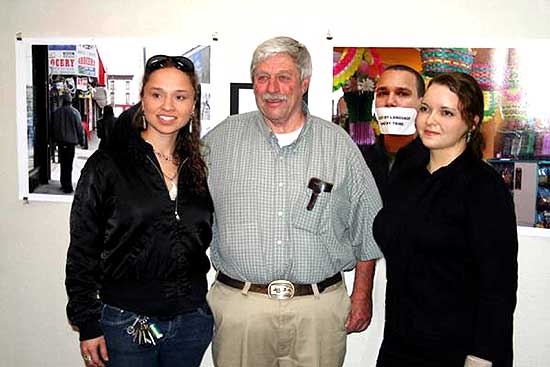 left to right: Courtney Leonard, Peter McLean, Dan Loudfoot, Nayana Glazier
left to right: Courtney Leonard, Peter McLean, Dan Loudfoot, Nayana Glazier
Untold Stories & Native Voices
Nashawannuck Gallery
Our media, styles and works are unique and could have stood on their own, however together they made a statement about the history, present and future of native people.At the reception held on the second Saturday of the month each of the three attending artists (McLean, Leonard and myself) spoke about the work on display and answered questions from attendees. McLean, professor Emeritus of Fine Arts at the Hartford Art School/University of Hartford in West Hartford Connecticut, spoke first (http://www.petermcleanfinearts.com/) and his years of teaching were evident as he discussed the sources of his large and impressive charcoal drawings. Each has its own life and history using historical events and native pop culture icons to suggest the Americanization and de-culturization of native peoples through pop culture and the historical canon. His “Disney Pox”, a 52”x 46” suspended charcoal drawing, uses images of Pocahontas with red pock marks and classic images of explorers with Americanized natives, comparing Disney to Small Pox in its negative effect on native life, or the perception of native life in modern culture. I then spoke on my work and the work of Dan Loudfoot. Dan’s work uses images from his interactive project “I lost My Language And My Tribe” about which Dan says:
“This work is a performance that deals with issues of colonization that I go through on a daily basis and this dis-connect I feel from living in present day American Society. I am a Pequot (Native American) artist. I am a direct result of what colonization has done to a people and the cultural disconnect that we face as a people. These words that I am writing and these words that I speak are not my own, my language was eradicated from my relatives mouths and I now speak English. This performance involves walking down the streets of Brooklyn, NY with my mouth covered with a piece of paper over my mouth with the words, “I lost my Language I lost my Tribe.” -Dan Loudfoot
Also included are pieces from his project of making paper dolls of himself and his loved ones in traditional regalia. He then takes those pieces to the Metropolitan Museum of Art where he uses some creative placement and a digital camera to place the figures as Christ-like in the museum’s religious depictions.
Dan had this to say about this project:
“My recent work has taken me to the Metropolitan Museum of Art here in New York City conducting performances in the Religious Icon Art galleries that explore various modes of hybridity. I use paper caricatures of my wife and myself in our traditional regalia and hold them at a distance from actual paintings; after taking digital photos of the caricatures that I am holding they create an illusion that they are actually in the painting. In this performance I am bringing “Native Americans” to a Holy Iconic form, a form that does not exist in American Mass Media today. Creating a voice of authenticity while bring light to these issues is core to my practice. This series of performances has opened up an ongoing dialogue with the public. This work stems from memories of my childhood spent in Catholic school after troubling experiences at the local public school. A non-Catholic, being an outsider forced to sit alone in the pews while the other children received their daily bread and wine. In St. Patrick’s church, I looked up at that man nailed to a cross and asked myself, “Where is MY creator?” …” -Dan Loudfoot
The last piece he included is “Everyone Wants to Be and Indian”. Dan had this to say about the piece:
“This is an interactive project where the audience is able to participate in my art making and revive early childhood memori
es. I have drawn a Halo with Bingo Paint (my casino Indian media) on construction paper in this work I am trying to bring Native Americans to the holy Iconic form that we rarely reach. This work stems from my memories in grade school around the times of Thanksgiving and having to wear construction paper headbands with feathers in them. This work also deals with the actual painting becoming a figure similarly to art in museums, galleries and public spaces. When people stand next to or in front of artwork and take their pictures. With my project “Now Everyone Can Be an Indian” the audience is invited to do so.” -Dan Loudfoot
My own work is always difficult to speak about. The work itself does come from reflection on my experiences and ideas. My earlier work dealt very clearly with being native in modern society and feeling out of place, showing brightly colored native peoples feeling out of place in a monochromatic cityscape. But my more recent work investigates the existential and the challenge of remaining entirely human.
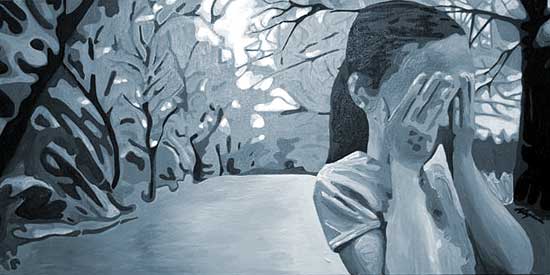 Nayana Galzier, Untitled, Acrylic, Nashawannuck Gallery, 2008
Nayana Galzier, Untitled, Acrylic, Nashawannuck Gallery, 2008Courtney Leonard then spoke on her work, its construction, where she came from and its purpose. What struck me was her candid nature in addressing the show’s concept. “Untold Stories & Native Voices”, Leonard Stated that by her experience these stories were not untold. Perhaps not heard, but certainly not untold. Her work calls on the skills she learned at RISD, her experiences traveling to different regions and missing her home on the Shinnecock reserve in Long Island. Though being native and an artist were part of her they were no more or less than her other history and experiences, her work spoke less to being native and more to being herself. Viewing native ceramic objects one might expect the traditional. Her work is more a representation of herself, her feelings, her experiences than the history of ceramics or a statement on modern art by native artists.
This got me thinking. My own work is now bypassing heritage to focus on humanity over label, individual sovereignty artist or not, native or not etc. Courtney had expressed similar ideas to me and so I set out to see if other artists from some of these exhibitions also engaged these issues.
Courtney mentioned the now famous Harvard show REMIX Indigenous Identities in the 21st Century at The Peabody Museum of Archaeology & Ethnology, Harvard University (April 5 – August 31, 2008.) REMIX features work by Doug Miles (San Carlos Apache), Ryan Red Corn (Osage), Courtney Leonard (Shinnecock), and an artist I’ve mentioned extensively on Artist Organized Art, Bunky Echo-Hawk (Pawnee and Yakama) also included is rapper Quese IMC. In REMIX, these artists transform traditional materials, ideas and iconography into contemporary art. The exhibition is curated by Kelsey Leonard, Tanner Amdur-Clark, LeRenzo Tolbert-Malcom, and Caitlin Young, members of Native Americans at Harvard College on behalf of the Ivy Native Council.

left: Douglas Miles with famed Hip-Hop photographer Ernie Paniciolli,
his film The Other SIde Of Hip-Hop was shown at REMIX Harvard
right: Douglas Miles, LOVEThat the show was presented at The Peabody Museum of Archaeology & Ethnology spoke volumes. Why are Native cultures, among the most heavily studied groups of different peoples under the same umbrella ever assembled in North American history, stuck in a time freeze. A view perpetually studied in the past tense, so much so that even virtually self organized contemporary art which, by global standards, is practiced by very contemporary artists, would still only find venue at the enlightened authority, Harvard University, through an archaeological and ethnological spin.
Archaeology – noun 1. The scientific study of historic or prehistoric peoples and their cultures by analysis of their artifacts, inscriptions, monuments, and other such remains, esp. those that have been excavated. 2. Rare. ancient history; the study of antiquity. -www.dictionary.com
What is the function of such an alienating, analytical and clinical form as to be “studied.” Some of the works in the exhibition were only created months before the show was hung, yet they are observed in the same respect that works are studied in a museum of natural history. The overwhelming consensus among the artists I have spoken to is the desire to be seen as artists, to have their work appreciated on its own regardless of the artist’s ethnic affiliations or any other factors than the merit of the work itself.
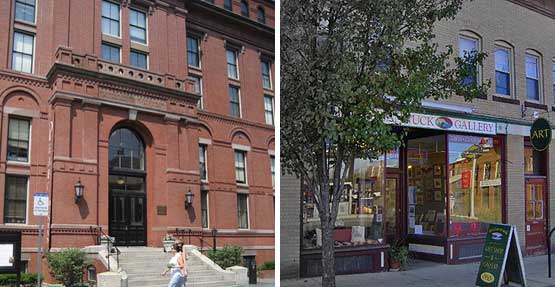 left: The Peabody Museum of Archaeology & Ethnology, Harvard University
left: The Peabody Museum of Archaeology & Ethnology, Harvard University
right: Nashawannuck Gallery, Easthampton Massachusetts I was fortunate to interview Douglas Miles briefly and get his perspectives on things.
“…It is tiring and somewhat demeaning (to artists / natives) in a certain sense. Because even though it is meant to serve an educational purpose it also serves to commodify and cleanly categorize a whole “people” in nice little dioramas, placards or booklets without respect to very real complexities…This is not to disrespect staff or “experts” in those fields, however why do we have to show in an “Anthropological (Archaeological) Museum?” Are we not artists with valid points of view like any other artists from any other background?….all artists should endeavor to let their ART speak for itself without regard for the ethnicity of its maker.” -D
ouglas Miles
Nayana Glazier(NG): Knowing that you question the idea of the native themed exhibition based solely on the fact that the work was produced by native artists, and considering that all of us at our core would prefer to be known as artists and not specifically native artists…would you continue to participate in native themed shows in the future?
Douglas Miles(DM): It’s not that I question the purpose or reasons for showing. It’s time for a new paradigm. The places we show(Anthropology Museums and Museums of Natural History etc…) seem to already dictate how our art is to be viewed, taken and is/isn’t accepted. That is why new venues need to be discovered challenged, sought out or hi-jacked because time is short. I will support any show, curator, museum, gallery or collector(s) who does not try to label, categorize, define or pigeonhole what we (as artists) do.
The Harvard REMIX is/was revolutionary in that students (Youth) came up with the concept, felt these artists are significant voices of change, and requested us there. They basically hi-jacked some Museum space at Harvard and allowed us freedom to create. In “Native Art” that is almost unheard of with the exception of my projects like www.thenativeagents.com or www.apacheskateboards.com which not only include art but skateboarding, poetry, film, photography, sculpture, performance, music and whatever else we want to make. Major museums are now trying to emulate the concepts we built. Some are even opting to dis-include us from their discourse as they attempt to replicate our innovation. However what Apache Skateboards, The Native Agents and myself have done is well documented. It is art for the people.
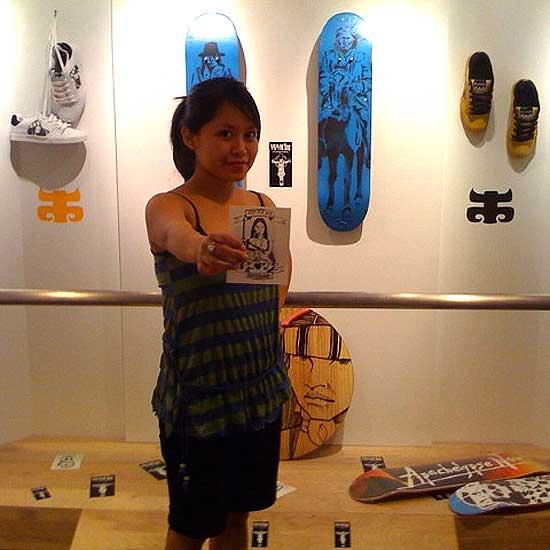 Douglas Miles, Art For The People, apacheskateboards.com, 2008
Douglas Miles, Art For The People, apacheskateboards.com, 2008
with Kelsey Long in photo
NG: Would you try to gear your career more toward shows about art and not the cultural backgrounds of the artists or the cultural themes in the work?
DM: My art takes on a life and direction of its own. Though I am the composer, like a jazz musician, I’ve learned to improvise , embrace new styles, and work in various settings. It is almost impossible in the Native Art field to create a show concept that is not about your tribal background. However more and more I am being asked to participate in non-Native themed shows. I am not trying to “gear” my art in any direction. Nor am I trying to “cross-over.” When an artist begins to understand the power of their own voice, develops a style apart from the norm and learns to walk blindly yet boldly into opportunity, their work can go anywhere. Good work can and should transcend any real or imagined boundaries. If I’m geared up for anything its to have fun with my work and work with others who share similar goals. It (the art) is taking me where it wants and needs to go. It is leading me into clothing/product design, the street art movement, underground galleries, film work, photography, performance, poetry, media, magazines, books, and a longer list of projects in the works. My job is to listen to my art and allow it to breathe and exist in the fields alleys, hallways, theatres, back streets or wherever and with whomever wants to see and be part of it.
NG: Do you feel that this theme of show which is sprouting up around the country will eventually pigeon hole many of the artists involved? Or do you think that some or most of the artists will be able to define themselves as artists and humans first and native artists second?
DM: The Harvard REMIX is unique in the sense that students not ” Native Art Experts” curate the show. I would hope that this type of guerrilla art show becomes the norm. It allows access to artists who do not get any. Meaning access (to venues) is usually defined by who has the longest curriculum vitae or who has sold the most art or who has befriended the coolest curator/collector etc. All artists should try to be as human as possible. I hope I’m doing a good job. Artists need to be as creative as possible and as true to their current “here and now” as possible.
My current work is not romantic. It is dirty/gritty and not easy to look at. This is how our communities affect us. I am part of a community and a tribe. It will always inform the work that I do. However it does no artists any favor to constantly refer to their ethnic background as some kind of relevance. Especially if their art is mediocre. An artist’s work must always do the talking. Eventually critics, writers, patrons will figure out that the artist is from somewhere. Artists (Native) really need to begin to look for ways to be as freely creative as possible without the demands of a “market”. It may be awhile before that occurs yet it is necessary in order for art to flourish.
Keeping everything in mind that I have learned through this experience I can only speak from my own experiences and perspectives on what will happen with these kinds of exhibitions in the future. To be honest I think none of us can deny the allure of the exhibition regardless of theme or label that might be attached to it and subsequently us as individual artists. But when it comes to the idea of a native themed show with a grouping of artists who are brought together solely because they share a set of genealogical traits is one that is unavoidable for anyone. Who we are, weather we try or not, is directly reflected in whatever art we as artists individually make and as such our heritage comes though. It might be the feeling of a lack of heritage or the abundance of it that shines through behind the indistinguishable that makes us stand out as native artists but it is there. It would be foolish for any of us to deny it or try to stay away from it, it is who we are as much as anything else. Presenting us together as separate artists under the same umbrella can both be to our benefit and detriment depending on the audience and the location. In some respects being categorized as an ancient civilization has leant itself very well to opening the discussion on that very subject. Surely seeing modern art in an archaeological context is a different sort of education and experience for the students at Harvard studying our modern day historical artifacts. So long as these ideas are presen
ted along side the work, that the body of combined artists and styles are presented as such different people from different backgrounds, brought together on one basis only…their ethnic heritage, their differences being the educator to those attending, to bring their concepts and understanding of indigenous cultures to the same stand point that they would think of people of other ethnic backgrounds and possibly take one small step closer to earning ourselves a spot as an easily recognized modern people. As complex, modern and Americanized as anyone else.
Personally I will continue to support and participate in these exhibitions whenever possible in the hopes that soon they will move past the historical stage and into the modern art world so that each artist can have their work seen on its own for what it is and not just what label they fit under.
#permalink posted by Nayana: 6/20/08 12:32:00 PMThursday, June 5th, 2008
Théâtre de la Cité Internationale, Paris, FranceScenes Ouvertes à L’Insolite
covered by artist Angie Eng
Théâtre de la MarionnetteThéâtre de la Cité Internationale, Paris, France
15-25 May 2008http://www.theatredelamarionnette.com/scenesouvertes.html
In a country rich with history, how does one approach innovation? Experimental Tradition seems to be all too common in the Art Festival de Paris. For three weeks in May, Le Théâtre de la Marionnette presented ‘Scènes Ouvertes à L’insolite’ (Open Stage For The Unusual) This umbrella program of cross-genre theatre included: theatre of manipulated objects, puppetry, video, shadow play, circus, spoken word, magic show, contemporary dance/movement, actors, tap dancers, improvisational music, poets, ‘clowns’, mimes, did I forget anyone, anything? From the description of sub-genres the public is immediately informed to not expect the Muppet show. The closest might be Daisy/Violet, the ½ human ½ puppet Siamese twin strippers of “Me Too, A Sideshow,” a performance ode to “Freaks” that merges the roles of object and manipulator.
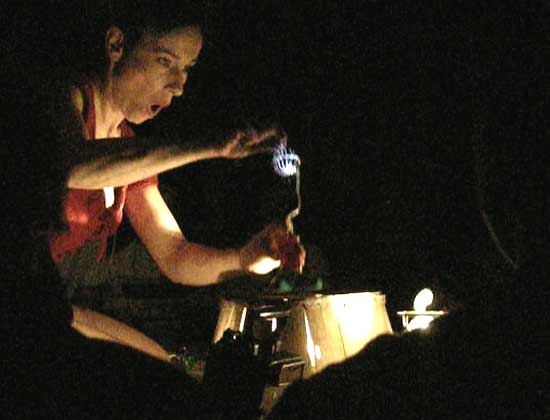
What we do realize after viewing a few performances, in my case 7 of the 14 presentations, is each collective remains faithful to the exploration of reality through the discovery of the make-believe. In other words, facing death by rebirth. As with a magic show, suspense is the key emotion to unravel the cycle of personal development. Like the art student exploring a canvas by copying the masters, the actor/manipulator reveals how the mind confronts existence. In “Desirée,” we are thrown into the cellar with a suffering abused girl who survives by recreating a dialogue between self, object and an imaginary persona. In coping with fear she displaces all emotion into gestural scenarios. Here is a production that presents ‘playing dolls’’ in a most dramatic, intense one-person drama, grâce à the performance of Coco Bernardis. And an honorable mention to the improvisational musician, Antoine Arlot who truly played visual sound.
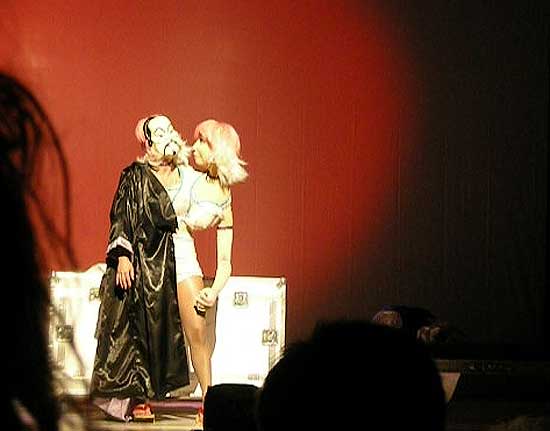
“Mr. H” (an adaptation of Dr. Jekyll and Mr. Hyde) is also a whirlwind in connecting the self with its multiple attempts and failures to illustrate life is a process. Visually dazzling as if watching a circus on acid, the three actors and one puppet move on, off, behind, sideways while playing tap dancing apes, reproducing via overhead projector “Journey to the Center of the Earth” mad scientist, syncing lights and alarms à la Richard Foreman, mocking Hollywood shadow dance and borrowing Film Noir in their mystic hysterics. Well, ‘I-can’t-remember-how-it-ended-but-I-liked-it-anyway’ was my reaction. It takes courage to cross the border.
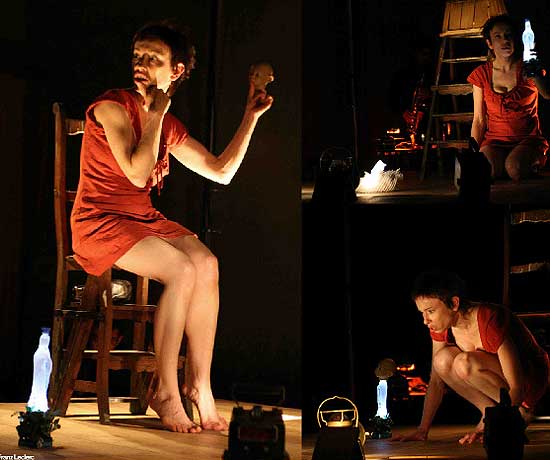
I’ve worked 15 years with experimental technology under the label of ‘New Technology’, ‘New Media’, ‘Interactive Performance’ and/or ‘Experimental Video’. 50% of the time the questions were geared toward equipment brands and software development in-progress. Questions of poetry and content were non-existent. In “Me Too: A Sideshow,” the story is about a baby puppet recounting his Siamese twin mother who reminisces of a time in a caravan by way of a video clip. (Did you catch that hall of mirrors?) Here, cinema is used as a dimension that could only be expressed by a window of moving images. (And nobody would ask how many lumens was the projector nor the name of the digital effects applied on the video!) Last month on the outskirts of Paris, I found myself every Sunday at the Théâtre de la Cité relearning the lesson on how marketing can jet your audience to a glacier mountain when the meeting point was in the Sahara. Under the heading of “Marionnettes” aesthetic parallels provided the base to the limitless use of tools and definition of ‘spectacle’.
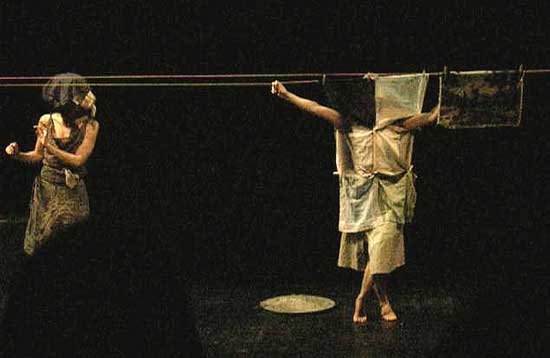
In Encore des Changements a poet crawls on the floor like a handicapped child reaching for a cord. Video projection is used to recite words projected on her arm as cinematic tree silhouettes dance inside the painter’s paint. At one point she fondles a huge mass of cotton like a Fluxus inspired media artist dancing with paper (Jessica Higgins in “North Water Song”). It’s so sensual you want this moment of simplicity that fulfills an urge to last longer. Spirituality and sensuality make a good couple. In the end as in the beginning and middle of the piece, a combination of techniques is used to examine the fragility of existence. The narrative arch seemed to be underdeveloped. Be that as it may, I still look forward to the next attempt.
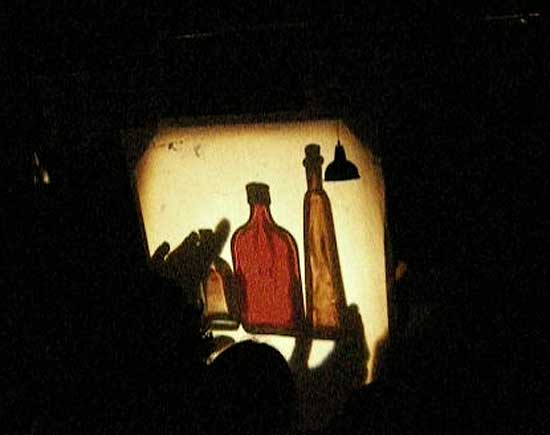
Incorporating cinema or merging forms effectively is no easy feat. However, the Festival Scènes Ouvertes à L’insolite’ gave me hope again. Breaking rules is necessary in experimentation, however there is a certain tradition that holds true- Start with a foundation and voyage to the ephemeral can bring fruitful results.
#permalink posted by Angie Eng: 6/05/08 10:16:00 AMSaturday, May 3rd, 2008
Lance Fung InterviewedCreating Community at Lucky Number 7
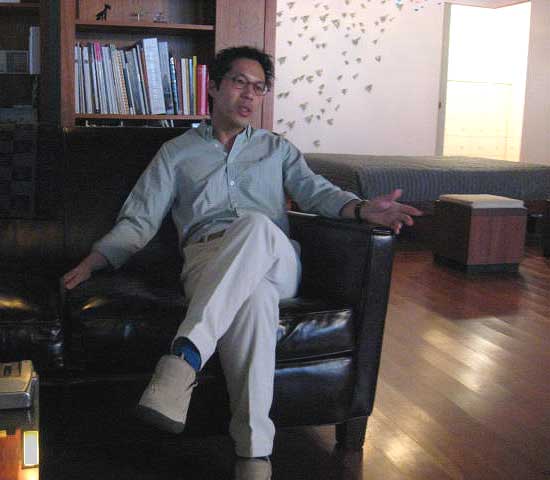 Lance Fung in interview with Artist Organized Art, March 30 ‘08
Lance Fung in interview with Artist Organized Art, March 30 ‘08Artist Organized Art
This Artist Organized Art interview with curator Lance Fung is conducted by Joshua Selman and Erika Knerr, on March 30, 2008 at Lance’s SOHO loft in Manhattan. It weaves together formative influences behind his first International Biennial, Lucky Number 7, at Site Santa Fe, opening June 20-22, 2008. The interview precedes a pot luck dinner at his loft attended by his core community of friends and family. Gathering at the space several times a year, most among them are former Lance Fung Gallery artists.
Here are two excerpts from the full interview:
AOA: The question was if your way of curating is considered to be a reverse engineering of the normal curatorial process, and where the curatorial function of the institutional partners fits in?
LF: I wouldn’t say it’s a reverse procedure, because that would mean there would have to be strategy to my work, there’s no method to my madness, I am who I am. I act, say, speak, think, write, dress, the way I do, you couldn’t, and I’m forty five now, so I don’t actually give a damn what people think of me, I get it when Holly Solomon said she didn’t care –“I’m Holly Solomon,” — well finally now I’m Lance Fung, you like it, you don’t, can it be improved? Yes. Will I change it your way? Maybe, maybe not, and this is the point of being free as an artist and curator, as an individual, its not that you’re like “oh everyone doesn’t know what they’re talking about…” but it’s just that you’re not concerned about pleasing someone, and by not trying to please someone you have a greater chance of pleasing someone, because you’re grounded, you’re satisfied, you have something to give, so I don’t think so, now surely that most people would look at it that way, because it isn’t the way most people would curate a show, I do see, however, a trend in people, a trend with younger curators trying to curate. In approaching their new practices in the way that I live my life, so I’m not necessarily saying they’re copying me, but collaboration is coming up quite often now, but in a very different way and typically in a very superficial way, but what’s nice is I think that my work has somehow seeped into the way people are looking at things, including some of the seasoned curators. Because, you can’t work in an antiquated mode, and that’s why people are trying, the art speak is becoming less and people are doing more common speak when they’re talking about a show. Or, they’re having a greater awareness of the general public in appreciating the work where, in fact, after the fact, I realized that was the main audience for The Snow Show, and that’s what made it so profound, so I don’t know, that’s not for me to answer.
AOA: In terms of the process of Lucky Number 7, of course, there are ancestors, for example, The Snow Show, Lance Fung Gallery, Construction In Process, Ryszard Wasko and The International Artists Museum, Charlotte Moorman and the Avant Guard Intermedia Festivals, Allan Kaprow, Billy Klüver, George Maciunas, Nam June Paik, etc. This brings up the comparison of “curating” to “organizing.” How do you see the comparison?
LF: I almost had Construction In Process in my essay, but when I showed it to international curators. most of them had not heard of it. So I just linked to a very general subject of something that was much less interesting to me until much later in my Lance Fung Gallery time period and that was Fluxus. Okay, Nam June, yes, but I don’t think of him as Fluxus even though he is Mr. Fluxus. So, it does parallel to a lot of what Fluxus was about, this impromptu happening sans curator, it’s artist inspired, it’s “artist organized art” and Construction In Process is a little bit like that, because it did have, from what I know in the books and what I’ve heard from you guys, less of a curatorial roll and more of an energy and synergy that came about. So, definitely aspects of Lucky Number 7 are coming from Fluxus, Construction In Process, Lance Fung Gallery and a ton of other references.
It’s interesting. Everyone will call this biennial so many different things. “The anti-biennial,” because they can either be talking in response to other biennials and what they stand for, marketing, branding, PR, or they can even talk about anti-market, because the works are ephemeral. It could be anti in many ways. Again, there’s none of that strategy involved with Lucky Number 7. Essentially, in Lucky Number 7, I, as curator, have digested everything I’ve learned, seen and heard of in the art world that I like. Which has made me the curator that I am, because then I work in that mode as opposed to in a very commercial glitzy way. Which parallels Construction In Process, but the big difference there is that organization or production vs. curation are apples and oranges, and often as you well know with The Snow Show, I’ve had to wear all 3 hats, where I would most prefer wearing only the curator’s hat. Not worrying about fund raising and legal and administrative issues, not worrying about promoting it, but just dealing with the curatorial end, would be great and that’s what a curator “was.” But, in the new decade or millennium it shifted where almost every curator is out there “shakin’ a tin can.” Whether you’re working for a big proper museum or you’re doing a freelance show you’re out there with the Press, because that’s another way to get visibility, so that when you’re “shakin’ the tin can” people are dropping a quarter in yours vs. someone else’s. All of a sudden I kept feeling rather inadequate with The Snow Show, having to do all of this stuff. And, I felt slighted, like, “why am I having to do this as a curator?” Well guess what? The world caught up to me in a negative way when it was much better for the curator just to curate, someone else to write the check, and someone else to go out and talk about it. Another thing I’ve always been a little embarrassed about is my commercial background. In fact, I pulled it out from all
of my bios and website and really eliminated Holly Solomon Gallery and Lance Fung Gallery, because very few, if any, curators made the transition from the commercial world to the not-for-profit world. Some went the other way because then by being an important curator, or with a museum, you can be paid more by working in a gallery, but going in the reverse direction, from “money” to “no money,” is “crazy.”
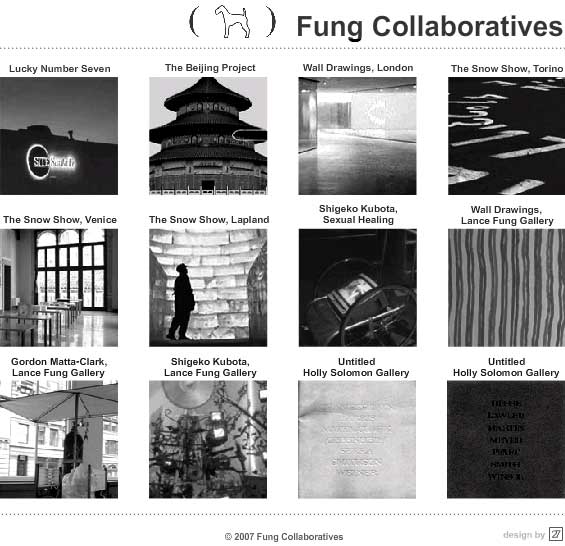 Lance Fung runs Fung Collaboratives, LLC
Lance Fung runs Fung Collaboratives, LLCAlso, the credibility is weak, because curator as dealer or dealer as curator has a lot of conflict of interest. We talked about it with The Snow Show. How many artists, that I’d worked with in the past, could I put in The Snow Show without it looking like there was favoritism, or commercial gain. Particularly when Finland was up, so was my gallery. I asked – people said “oh three to five artists based on your group.” In the end I only did two, John Roloff and Top, otherwise I would have put more, not because I was trying to promote the gallery, but because I believed in them. So it’s interesting, but I was speaking at this conference on public art with all these other curators Jan Debbaut (formerly of The Tate) organized and they said “but, weren’t you at Holly’s?” I said “yes, but I don’t talk about that,” and they said “why?” I said “well…” they said, “you’re’ wrong because right now that commercial background you have is so needed and most curators don’t have that information.” A) They don’t know how to buy a work of art for the institution. B) They don’t know how to talk about discounts etc. So it’s very funny, curatorial work is evolving and it is including someone odd like me, because normally I wouldn’t fit into that category, but I actually don’t think it’s for the better to be quite honest.
Lance Fung is an independent curator based in New York City. One of Fung’s most well known projects was The Snow Show exhibition, realized in 2004 in Lapland, and in 2006 in Torino, Italy for XX Olympic Winter Games. Prior to his independent curatorial endeavors worldwide, he had an eponymous gallery in New York, and was the director of Holly Solomon Gallery.
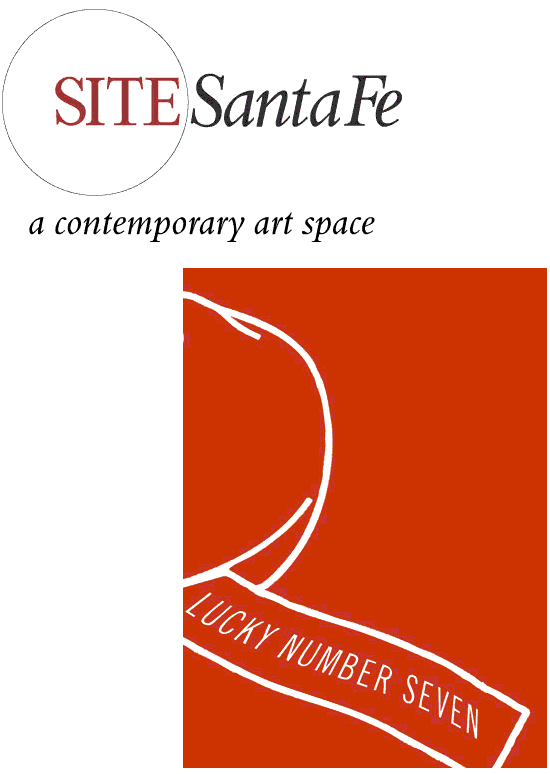 Lance Fung curates International Biennial, Lucky Number 7, at Site Santa Fe, June ‘08
Lance Fung curates International Biennial, Lucky Number 7, at Site Santa Fe, June ‘08
Since its opening in 1995, SITE‘s mission has been to bring the global contemporary art dialogue to the Southwest region of the US. SITE’s Biennial, organized by a guest curator of international reputation, always attempts a paradigm shift in the field of visual arts. SITE’s Biennial is known worldwide for its innovation and for showcasing great curators ahead of the rest of the art world. In fact, three of SITE’s six curators have subsequently served as Directors of the Venice Biennale, including this year’s Robert Storr, and a fourth won a MacArthur “Genius” Award.
Lucky Number Seven Curatorial Team and Partner Institutions:
1. Ferran Barenblit, Centro de Arte Santa Mónica (CASM), Barcelona, Spain, www.centredartsantamonica.net2. Iara Boubnova, Institute of Contemporary Art – Sofia, Bulgaria, www.ica.cult.bg3. Gregory Burke, The Power Plant, Toronto, Canada, www.thepowerplant.org4. Colin Chinnery, Ullens Center for Contemporary Art, Beijing, China, www.ullenscenterforthearts. org (Partnering with Centre for International Cultural Exchange, China, www.seechina.com.cn)5. Alexie Glass, Gertrude Contemporary Art Spaces, Melbourne, Victoria, Australia, www.gertrude.org.au
6. Lukasz Gorczyca and Michal Kaczynski, Stowarzyszenie Integracji Kultury (Association of Cultural Integration), Warsaw, Poland, www.raster.art.pl
7. Laura Steward Heon, SITE Santa Fe, New Mexico, United States, www.sitesantafe.org
8. Barbara Holub, Secession, Vienna, Austria, www.secession.at
9. Vasif Kortun, Platform Garanti Contemporary Art Center, Istanbul, Turkey, www.platformgaranti.blogspot.com 10. Chus Martinez, Frankfurter Kunstverein, Frankfurt, Germany, www.fkv.de
11. Martina Mazzotta, Fondazione Antonio Mazzotta, Milan, Italy, www.mazzotta.it
12. Tsukasa Mori and Yuu Takehisa, Art Tower Mito, Japan, www.arttowermito.or.jp
13. Joseph Sanchez, Institute of American Indian Arts Museum (IAIA), Santa Fe, New Mexico, United States, www.iaia.edu
14. Patrizia Sandretto, Fondazione Sandretto Re Rebaudengo, Turin, Italy www.fondsrr.org
15. Guillermo Santamarina, El Museo Experimental, Mexico City, Mexico
16. Hyunjin Shin, SSamzie Space, Seoul, South Korea, www.ssamzies
pace.com
17. Alessandro Vincentelli, BALTIC Center for Contemporary Art, Gateshead, England www.balticmill.com
18. Marc-Olivier Wahler, Palais de Tokyo, Paris, France, www.palaisdetokyo.com
19. William Wells, The Townhouse Gallery, Cairo, Egypt, www.thetownhousegallery.comSpecial thanks to SITE’s local residency partner,the Santa Fe Art Institute
Artists
1. Martí Anson Born in 1967 in Mataró, Spain Lives and works in Barcelona
2. Studio Azzurro: Fabio Cirifino (born in Milan), Paolo Rosa (born in Rimini), Stefano Roveda (born in Milan) and Leonardo Sangiorgi (born in Parma), Located in Milan, Italy
3. Erick Beltrán Born in 1974 in Mexico City Lives and works in Barcelona and Mexico City
4. Luchezar Boyadjiev Born in 1957 in Sofia, Bulgaria Lives and works in Worpswede, Germany
5. Michal Budny Born in 1976 in Leszno, Poland Lives and works in Warsaw
6. Ricarda Denzer Born in 1967 in Kirn, Germany Lives and works in Vienna7. Hiroshi Fuji Born in 1960 in Kagoshima, Japan Lives and works in Fukuoka, Japan
8. Fabien Giraud Born in 1980 in France Lives and works in Paris
9. Piero Golia Born in 1974 in Naples, Italy Lives and works in Los Angeles
10. Soun Myung Hong Born in 1959 in Seoul, Korea Lives and works in Seoul
11. Scott Lyall Born in 1964 in Toronto, Ontario Lives and works in Toronto
12. Nick Mangan Born in 1979 in Geelong, Victoria Lives and works in Berlin
13. Eliza Naranjo-Morse Born in 1980 in Espanola, New Mexico Lives and works in Santa Fe
14. Nora Naranjo-Morse Born in1953 in Espanola, New Mexico Lives and works in Espanola
15. Ahmet Ögüt Born in 1981 in Diyarbakir, Turkey Lives and works in Amsterdam
16. Mandla Reuter Born in 1975 in Nqutu, South Africa Lives and works in Berlin
17. Nadine Robinson Born in 1968 in London, England Lives and works in New York City
18. Zbigniew Rogalski Born in 1974 in D_browa Bia_ostocka Lives and works in Warsaw
19. Wael Shawky Born in 1971 in Alexandria, Egypt Lives and works in Alexandria
20. Raphaël Siboni Born in 1981 in France Lives and works in Paris
21. Rose B. Simpson Born in 1983 in Santa Fe, New Mexico Lives and works at Santa Clara Pueblo, New Mexico22. Shi Qing Born in 1969 in Inner Mongolia, China Lives and works in Beijing
Biennial Leadership
Lead Underwriter
Jeanne & Michael L. Klein
Curator’s Patron
Marlene Nathan Meyerson
Honorary ChairsAnne & John Marion, The Burnett Foundation Margarita & Albert Waxman
Exhibition PatronsAnonymous, Karen & Steve Berkowitz, Virginia Dwan, Agnes Gund & Daniel Shapiro, Jeanne & Jim Manning, Millstream Fund, Mary Lawrence Porter, Margaret Robson, Alice C. Simkins, Ann Tenenbaum & Thomas H. Lee
Exhibition SupportersDottie & Dick Barrett, Cornelia Bryer & Herman Siegelaar, Bobbie Foshay, Marian T. Fung & Family, Katherine & James Gentry, Mari & Peter Kooi, Mihail S. Lari & Scott E. Murray, Rosina Lee Yue & Dr. Bert Lies, Toby D. Lewis, Joanne N. McCarthy, Alicia & Bill Miller, Cindy Miscikowski & Doug Ring, Rita & Kent Norton, Lorlee & Arnold Tenenbaum, Kathy & Charles Webster, Nancy Ziegler Nodelman & Dwight Strong
Artists’ PatronsMiguel Abreu Gallery, Susan Hobbs Gallery
Exhibition Friends
Anonymous, Gay Block & Rabbi Malka Drucker, Tina & Robert J. Denison, Sally & Thomas Dunning, Judith & Richard Greer, Pat T. Hall, Amanda & Keith Innes, Jeri Berger Hertzman & Dr. Philip Hertzman, Mary Kahlenberg & Rob Coffland, Carol Prins & John H. Hart, Crennan & David K. Ray, Courtney F. & Scott Taylor, Susan Steinhauser & Daniel Greenberg, David Teiger, Bebe Woolley & Daniel Gorski, Sandy Zane & Ned Bennett
Corporate SponsorsUBS Financial Services, Houston Sotheby’s
Special Events SponsorsGebert Contemporary & Chiaroscuro Contemporary Art, Landfall Press, James Kelly and SITE Unseen 5
Supporting Cultural OrganizationsArts Council Korea, Austrian Cultural Forum, New York Canadian Council of the Arts, Cultural Services of the French Embassy, Goethe-Institut, Los Angeles Institut, Ramon Llull Italian Cultural Institute, Los Angeles, The Japan Foundation, Polish Cultural Institute, Sociedad Estatal para la Acción Cultural Exterior (SEACEX),
Biennial Weekend Event Chairs
Cornelia Bryer & Herman Siegelaar
Residency Partner
Santa Fe A
rt Institute
Honorary CommitteeCo-Chairs, The Honorable Bill Richardson Governor, New Mexico, The Honorable David Coss Mayor, Santa Fe
Committee Members
Dr. Indrasen Vencatachellum Chief of Section for Arts, Crafts & Design, UNESCO, Ambassador Dennis Richardson Embassy of Australia, Ambassador Eva Nowotny Embassy of Austria, Consul General Alain Dudoit Embassy of Canada, Ambassador Pierre Vimont Embassy of France, Ambassador Klaus Scharioth Embassy of the Federal Republic of Germany, Mariusz M. Brymora Culture & Public Affairs Counselor Embassy of the Republic of Poland
Off-SITE Location Partners1005-G Alto Street Center for Contemporary Arts, Georgia O’Keeffe Museum, Institute of American Indian Arts, Museum of Indian Arts & Culture Museum of International Folk Art, National Dance Institute, New Mexico Department of Cultural Affairs, Palace of the Governors Santa Fe Opera School for Advanced Research
Additional SupportNew Mexico Department of Cultural Affairs’ Office of Media Initiatives & students from the College of Santa Fe, NM Highlands University & Institute of American Indian Arts Santa Fe Art Institute, Warehouse 21,
www.santafelucky7.comSITE Santa Fe is fortunate to partner with an extraordinary student documentary team, which is hard at work not only to document Lucky Number Seven, but also to incorporate the show’s guiding principles-experimentation, collaboration, process, and community-into its final product. The documentary component of the project aims to convey the spirit of the exhibition and to serve as a lasting record long after the artists have gone and the exhibition is over. The finished product will be presented at SITE in the exhibition and online at www.santafelucky7.com.
The filmmakers wish to thank biennial curator Lance Fung, the artists, and SITE Santa Fe for allowing the access and the opportunity to create this project. Thanks to the New Mexico Department of Cultural Affairs and the academic programs: the Media Arts Program at New Mexico Highlands University, the Documentary Studies Program at the College of Santa Fe, and the New Media Arts Program at the Institute of American Indian Art, and for funding from the Mandelman-Ribak Foundation. SITE wishes to thank HD Solutions for its support of this project.
Student documentation team
Kenneth Bachicha, Veronica Black, Jeana Francis, Jason Jaacks, Carlo Martinez, Megan Fisher McHugh, Marni Samuels, and Paul Conley. The project is coordinated by Eliot Fisher from the College of Santa Fe under the overall direction of Mimi Roberts, DCA Director of Media Projects. Faculty advisors are Professors Robert Drummond and Miriam Langer from the NMHU Media Arts Program, Tony O’Brien from the CSF Documentary Studies Program, and Carlos Peinado from the IAIA New Media Arts Program
#permalink posted by Artist Organized Art: 5/03/08 04:11:00 PM


